It may have signaled the demise of the Skyline name and the RB26 engine, but it re-wrote the rules on what is possible with a performance car. Here’s our ultimate R35 Nissan GT-R tuning guide.
When die-hard Skyline GT-R fans first heard rumors that Nissan was developing a replacement for the iconic R34, they feared the worst. Gone was the unburstable RB26 engine, the styling would presumably take inspiration from the bland V35, and the very moniker of Skyline itself was also for the chop. Things were not looking good. However, when the R35 was finally unveiled and released to the public in 2007, any critics that were predicting the downfall of Nissan’s flagship performance car were soon silenced.
A truly phenomenal machine, with unbelievable performance figures that seemed to defy physics, this was not just a step up from the R34, but a quantum leap that saw the new GT-R earn the respect of not just Nissan fans, but the motoring world as whole. Even manufacturers of the most exotic machines on the planet took note – not only because the four-seat R35 could keep pace, but also because it was available from around $50,000, a fraction of the price of its rivals.
The VR38 engine
As the first GT-R to be sold globally, the first R35 boasted a savage 473hp from its hand-built twin-turbo 3.8-litre VR38DETT V6. Good for 0-62mph in 3.2 seconds, the four-wheel drive R35 dropped the HICAS system and debuted a 4WD independent transaxle with a rear-mounted six-speed dual-clutch gearbox.
Initial reports were that the R35 was almost un-tunable due to sophisticated electronics controlling every function, and most tuners suspected the new alloy V6 engine to be nowhere near as strong as the previous iron block RB26. But, in no time at all both these rumors were quashed, and now a plethora of highly tuned R35 GT-Rs – many pushing out more power than an RB26 has ever produced – exist worldwide.

Modifying the Nissan GT-R
Since its launch in 2007, a host of special editions and year-on-year revisions have pushed both the performance and price tag of the R35 to ever greater heights, with the 2022 GT-R Nismo topping the charts with 592bhp and costing a eye-watering $200,000!
But you don’t need to spend the budget of a small country to get an R35 that’ll outperform pretty much anything on the streets, as a well-tuned secondhand purchase can be had for a relative steal. Typical basic engine upgrades can give even early GT-Rs a massive 600bhp, and even when retaining standard engine internals and turbochargers you can get a brutal, reliable, and supercar smashing, 650bhp with similar amounts of torque.
This massive ability when tuned makes the GT-R one of the cheapest cars to tune to four figure power outputs, all the while retaining an unrivalled level of practicality and drivability that few other cars can sustain at these ridiculous power levels.
To help you choose a tuning path to GT-R heaven, we’ve broken the car into its component parts to give you specific advice on how to maximize each area.
So, want to build the ultimate modified Nissan GT-R R35? We’ll show you how!
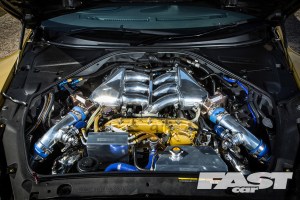
Nissan GT-R R35 Tuning: Engine
The R35 ditched the 2.6-litre straight six that powered the previous three generations of GT-R in favor of a hand-built twin-turbocharged 3.8-litre quad-cam V6 instead. Known as the VR38DETT it has standard power figures ranging from 480-590bhp, depending on the model year and if it was a special edition. All are equally receptive to tuning though, with well over 1000bhp achievable on pump fuel and some even twice that when running race juice.
Exhaust Tuning
The R35’s standard exhaust system features two sets of catalytic converters, and it’s the second set of these located in the Y-pipe section that should be your first port of call to replace if you are looking to unleash more power – and a deeper, more aggressive exhaust note – from your GT-R.
Both resonated and non-resonated replacement Y-pipes are available from companies such as Milltek, Japspeed and BR Motorsport that remove these restrictive catalytic converters, allowing the engine to breathe more easily whilst also offering weight savings over the original Y-pipe. Expect to pay anything from $500 up to $1500 for an aftermarket Y-pipe depending on the brand.
With the Y-pipe replaced, you can then move on to the rest of the restrictive standard exhaust system and replace the rear silencer. There are many companies that offer freer-flowing, larger bore systems in either stainless steel or more exotic materials such as Titanium, with a wide range in pricing (from around $1500 to over $8000) to match. Varying from 3 to 4 inches in bore with a wide variety of tailpipe sizes and designs, these will unlock even more power and sound from the GT-R’s VR38.
If the mid-pipe-back upgrades are still not enough to reach the power you crave, then a pair of de-cat turbo downpipes are required. These remove the primary catalytic converters and reduce exhaust back pressure further still, which results in faster spool, an increase in power and a more aggressive exhaust note. Prices start at around $450 for a pair to almost $900, so there should be an option to fit most budgets.
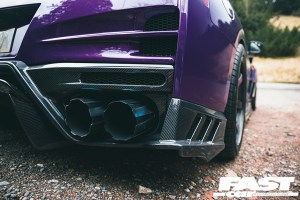
Intake Tuning
With the exhaust side of the equation complete, you can look at improving the R35’s intakes. If you want to keep the stock airboxes, then filter experts such as K&N offer direct replacement panel filters for around $150 which simply drop into place of the standard items and offer increased airflow while still retaining excellent filtration properties. However, these will only take you so far and, eventually, you will need to bin the stock airboxes and replace them with a pair of larger bore induction pipes with high-flow cone filters.
These are generally 3 inches or more in diameter and mount the cone filters down low in the front bumper to place them in an area of cold, dense air for maximum power gains. They also offer a larger cross sectional area which allows the factory MAF sensor to more accurately measure air flow – a crucial factor as power levels increase. Induction kits for the R35 start at around $500 and go right up to just beyond $2000 for a pair of AMS Performance carbon-fiber items. Beware that these require a suitable remap of the ECU.
If really big power is your goal, and we’re talking 800hp plus here, then you’ll have to budget around $5000 to $9500 for a replacement intake manifold from the likes of Boost Logic or AMS Performance. These will allow you to use larger 72mm throttle bodies ($1400 each), and will give the most evenly distributed and largest volume of boosted air into the cylinders. Add in the ability to run an additional fuel rail to allow even more super unleaded into the engine and you have the ultimate intake setup for the R35.
Boost upgrades
The R35’s standard turbochargers are effective units that work well up to around 650hp with a suitable ECU remap and supporting modifications to the inlet and exhaust system. Above this level, you’ll need to replace them. That’s an engine out job, worth combining with other upgrades that also require the motor to be removed to be most cost effective.
Depending what your power and drivability goals are – and we’re talking from 700 to 900hp at this stage – there are various direct replacement turbos available, mostly Garrett, Borg Warner and IHI units with billet compressor wheels. All are very fast responding while not significantly increasing lag. Litchfield’s $4000 stage 4.5 standard manifold turbo kit uses a pair of IHI turbos with billet compressor wheels and uprated actuators and are a straightforward bolt-on upgrade capable of up to 800hp.
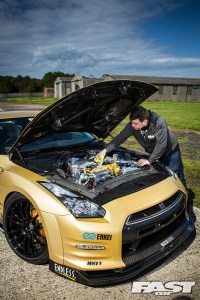
Fueling
The R35’s stock 570cc injectors can flow enough go-juice to run anywhere up to around 600hp, however, if you plan to go above this level, you will need to invest in some much larger units. Modern injectors have much more fine control than they did previously, so you can often oversize on injectors in order to futureproof your build without much in the way of drawbacks. Therefore, most tuners recommend an upgrade to 1100cc injectors from the likes of Bosch or ASNU, which will cost you around $1000 for a set of six.
Go much above 900hp, and it’s the standard rails themselves that will become the restriction, requiring an upgrade to something like AMS high flow rails for around $1200. Of course, with the right inlet manifold you can also run an additional fuel rail, which allows for even more injectors and thus more fuel enters the mix.
On top of the bigger injectors, you will also need to look to a higher flowing fuel pump such as those from Walbro or ASNU. These retail for around $150 and some are compatible with ethanol-based fuels too, although running high ethanol concentrations will require a $700 Flex Fuel kit, which monitors the amount of ethanol content in the fuel which can then allow the ECU to adjust accordingly.
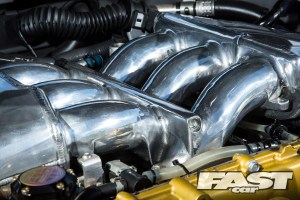
Uprated internals
For power levels up to 600-650hp, the stock VR38 internals should be fine, however, prolonged abuse or pushing beyond this level will require the engine to be opened up and a set of stronger forged conrods to be fitted. This is because the stock conrods are the weak point of the GT-R engine and can fail if too much is asked of them.
While the engine is in pieces, it is worth taking the time to fully balance the bottom end and also consider upgrading to forged pistons too, as this should then bulletproof the engine until well into the realms of 900hp+. Alternatively, if budget is not a consideration, you could always opt for a $7500 Brian Crower stroker kit, which takes displacement from 3.8 to 4.4-litres using forged internals and is good for anything from 1000 to a whopping 1700hp when combined with the appropriate supporting modifications to the head, fueling and turbos.
Remapping
When Nissan launched the R35, it was considered to be impossible to tune the car’s standard ECU. However, the clever men in white coats soon put paid to that notion and now the GT-R reaps huge benefits from the various software upgrades that are available to tune its electronic brain to power levels even beyond 1000hp. Two of the most popular software systems for mapping the stock ECU are the Cobb Accessport or ECUTEK systems. Both of these advanced systems can offer huge tuning options to the standard ECU, including adding advanced features such as data logging, rolling boost and extended boost gauge functionality. But it doesn’t end with the engine, as the GT-R’s complex ECU-controlled gearbox is also tweakable for faster, more aggressive shifts too. An engine ECU remap will cost in the region of $800, while a gearbox remap will be around $400.
With the stock ECU so capable, it means going for a standalone ECU isn’t as necessary in most cases as it is with many other performance cars, but that doesn’t mean it’s not still the best option for those seeking the ultimate in performance. A Syvecs standalone ECU will set you back around $5500, but will offer all the control you will ever need from stage 1 street cars right up to competitive circuit racers and even 3000hp+ drag cars.
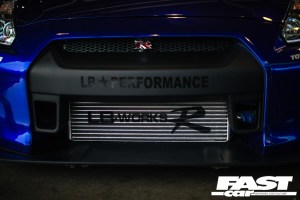
Cooling upgrades
Unlike most cars, the standard GT-R intercooler is very effective, but at this level a larger capacity version will give improved performance and reliability; GTC, Radtec, Japspeed and Forge Motorsport are all UK companies that all produce highly rated replacements for the standard unit with the Japspeed item coming in at $1800 for their MVT front mount intercooler kit. This includes uprated pipe work, claimed to offer 45% better cooling and unleash an extra 30hp on its own!
Camshafts
The VR38’s standard camshafts are perfectly capable of builds up to 1000bhp, but above this, you will need to consider upgrading along with other supporting modifications such as ported and polished heads and bigger valves, as well as larger turbochargers. Various brands offer uprated cams for the GT-R but common names include AMS, Kelford, Linney Engineering or GSC. Prices start around $1000 for a set of four, rising to over $2000 depending on specification.

Nissan GT-R R35 Tuning: Transmission
Clutch
The R35’s standard twin clutch is capable up to around 650bhp, but above this and you’ll need an uprated clutch such as an Xtreme billet kit to handle the massive torque levels produced. At around $5000 for the 18-plate model, these are not cheap by any means, but can handle much higher power outputs so should not need replacing again if you intend to scale the horsepower ladder any further.
Gearbox
The GT-R uses a slick shifting twin clutch transmission which is pretty beefy, but it’s not bulletproof and a few choice upgrades can help keep it in one piece. Firstly, swapping the gearbox sump for an aftermarket one, available from the likes of Forge Motorsport, improves the cooling and lubrication, meaning it’s more able to cope with the stresses put on it.
Another small but important upgrade while you’re tweaking the transmission is to add improved magnets. These pick up any debris in the transmission oil, but the standard Nissan ones aren’t considered strong enough. Thankfully GT-R tuners such at Severn Valley Motorsport and Litchfield Imports can supply and fit higher-powered magnets for very little money.

The final transmission upgrade, considered wise at this level, isn’t so cheap due to it being quite labour intensive, and that’s fitting uprated circlips to the end of the gearbox shafts. These are pretty weedy looking as standard and have been known to snap, especially with aggressive use of the launch control, and as the price to fit upgraded versions from the likes of Dodson is so much cheaper than the price to fix the repairs if one fails, it’s a wise investment.
A three circlip set without fitting will cost around $400. On top of this, you should also fit an uprated first gear to prevent the teeth being stripped on hard launches. The likes of PPG, Albins, and Shep Racing produce these, with the PPG upgrade costing around $2000, while a full 1-6 gearset from the same Australian manufacturer will set you back nearer $10,000.
Differentials
The problem with the standard front differential on the R35 GT-R is that it is an open design. This can result in the inside front wheel losing traction as the car squats coming out of corners on power. The all-wheel-drive system then reacts and tries to move the power to the rear, further upsetting the balance. The advantage of fitting an uprated limited slip differential such as those offered by Litchfield Motors (~$1000), is that it automatically biases torque, with a constantly varying degree, to the wheel that has traction. This massively reduces inside wheel slip without any negative side effects, while increasing steering feel, front-end grip and stability. Just be aware however, that fitting is quite labor intensive at around 10 hours if the engine remains in situ, which can ramp up the cost by around $1000.

Nissan GT-R R35 Tuning: Suspension
Springs and dampers
While you can swap out the R35’s standard springs for a set of H&R uprated and lowered options, and retain the stock dampers, we’d recommend jumping straight to a set of matched coilovers such as those from Bilstein, KW or Ohlins. All of these kits give you stiffer springs and dampers to offer greater body control, but also the opportunity to greatly tailor the way the car looks and handles via way of both height and damping adjustment. Litchfield offer their own coilover kit, developed with Bilstein in either road or track configurations, starting at $3500 for the road kit to around $5000 for the track kit.
Bushes
Most cars come with rubber bushes from the factory. They’re cheap, replaceable, and probably worn out by now, so replacing them with a firmer polyurethane upgrade makes a lot of sense. Not only do you get a genuine performance benefit of the stiffer bush and less unwanted flex in the suspension system, but they’ll never need replacing again in the future. Early R35s are now up to 15 years old now, so the OEM bushes are likely to still have some life left in them, but if you do get any which have perished or split, replacing them will be a priority, especially if you are planning any other suspension upgrades.
A front and rear suspension bush kit from the likes of SuperPro costs around $1000, but you can upgrade individual areas one at a time to ease the financial burden.

Anti-roll bars
Swapping your car’s springs and dampers to a stiffer set of coilovers is only half the equation when it comes to cornering. A set of uprated anti-roll bars will reduce the effect that weight transfer has on the car’s body roll when cornering, keeping the car flatter through the bend, in turn allowing all four tires to achieve a greater level of grip. You can increase your R35’s resistance to body roll by fitting stiffer and thicker anti-roll bars than standard, such as those made by Eibach. Coming in at $560 for uprated front and rear items, they will improve cornering and stability over the standard items.
Geometry
Whether it’s a set of lowering springs or a full coilover set up with uprated bushes, control arms and anti-roll bars, getting your car’s geometry alignment set up correctly is crucial to getting your handling working at its optimum.
An alignment specialist such as Centre Gravity can tune your GT-R’s suspension with pinpoint accuracy to work in harmony with your preferred driving style, whether that’s trips to the shops, or laps round the track.
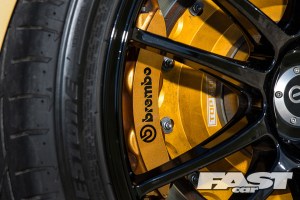
Nissan GT-R R35 Tuning: Brakes
The R35’s standard OEM discs are very good when new, but the drilled design leaves them with an innate weakness, making them prone to cracking, especially when submitted to sudden harsh braking, such as that experienced on track. Improving your brake set up is without doubt one of the best and most important upgrades you can make to your GT-R.
Tuners Litchfield offer uprated Alcon rotors in either 380 or 400mm options with either lightweight alloy bells or using the stock Nissan bells with new bolts and springs. Starting at $500 for the rotor only option and moving right up to over $8000 for a pair of Surface Transform Carbon Ceramic discs and Pagid RS29 pads, there is a GT-R brake upgrade for any budget or specification level.
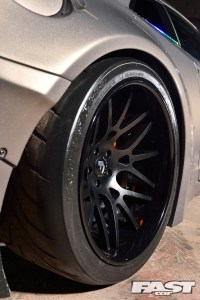
Performance Wheels & Tyres
The R35 comes with run flat tires from the factory, which although can help you out if you get a flat and enable you to still drive to safety or to a garage for replacement, they do not offer the same kind of ride or grip as you will get from a set of non-run flat options from the likes of Yokohama or Michelin.
Michelin Pilot Sport Cup 2 or Yokohama Advan Sport V105 are both excellent choices for maximizing grip levels on the GT-R’s standard 9.5x20in wheels (10x20in for Nismo variants). If you are more concerned with looks, or just want a different design or are looking for a lighter alternative, there are countless wheels available for the GT-R in sizes from 20-22in which will fit in the cavernous arches without issue.
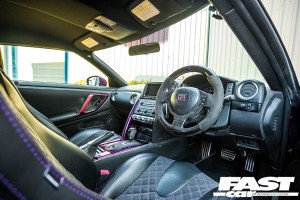
Interior Modifications
Nissan did a great job with the R35’s interior, mixing sporting intent with luxury in perfect harmony. With this in mind, few people stray far from the path Nissan intended, with high-end audio upgrades, opulent interior retrims or swathes of carbon-fibre trim the most popular interior modifications for the GT-R.

Styling Modifications
With the R35, styling upgrades come in all forms from mild to wild with everything from subtle lips and splitters to full-on wide-arch kits that completely transform the lines of the GT-R, such as the Liberty Walk LB-Silhouette Works GT 35GT-RR kit, which in full dry carbon comes in at an eye-watering $54,540 without fitting and paint!
For a less expensive and much more subtle option, you could always give your GT-R a modern makeover with Knight Racers 2017+ full conversion kit, which, for $8000 gives you everything you need to achieve a post-MY2017 look.
Words: Dan Sherwood.








